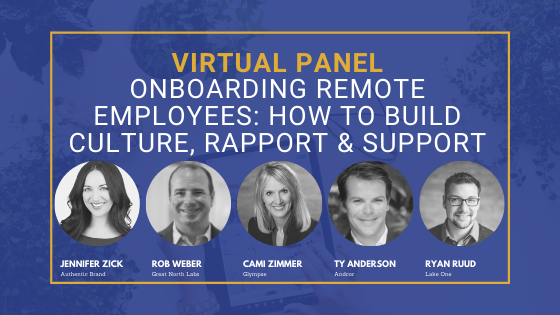Running a remote marketing firm provides a lot of benefits for our team and our clients. But having a team working from home most or all of the time isn’t without its challenges. One area that I get asked about a lot is how to successfully onboard a new work from home employee? How do you make sure they feel like they are part of the team quickly? How do you make sure they have the tools and access they need to get up and running quickly?
Here are some of the strategies that have worked for us. We also reached out to our network of business owners, managers and talent leaders to get their thoughts on strategies for managing onboarding remote employees. Their insights are included throughout.

Clearly Layout 30 and 90-day Plans
Whether your new team member is working from home or not – having a clear 30 to 90-day plan is so critical. SHRM points out that 69% of employees are more likely to stay based on their onboarding plan. At Lake One, we turn to the same tool we use to plan and manage our client Marketing Springs – Asana. We build out all the tasks and milestones for our new team members and link it up to the essential resources they’ll need to accomplish their onboarding from links to our standard operating procedure to the company drive file structure.
Jennifer Zick, Founder and CEO at Authentic Brand adds, “New employees – whether working in a physical office or remotely – need clarity in two primary areas in order to get up to speed and become productive in their roles. First, any new employee needs to know where to find what they need to do their job. Secondly, they need clear definitions on what they are responsible for, and what success should look like.”
Diversify Training and Communication Styles
Mix up the training schedule to make sure your new team member gets to spend time with a diversity of folks. This helps the new employee develop connections within the company and absorb information better. Not to mention, putting the responsibility on one person to get a new employee up to speed can be a lot.
Tyler Anderson, Principal at Andcor Talent states, “There is no one-size-fits-all approach to communicating during onboarding and beyond. Each leader (and team member) needs to understand communication preferences and needs. Some may prefer and are comfortable with email. Others need verbal communication and interaction. And others want a combo of both.”
Outline Subject Matter Experts
Make it clear – who in the organization owns what. This not only saves time across the board, but it sets expectations for both the new and existing employees. If you have a standard operating procedure (see below) this is a great place to put this information. Some HRIS systems also have a place for this in an org chart.
Anderson recommends, ”Getting them up to speed fast and hit the ground running by pairing the remote employee with an on-site employee or if everyone is virtual, another remote team member who they can go to for advice.”

Zick notes, “Many companies may not have well-organized online databases or platforms full of training materials, sales collateral, HR documents, or other resources that new employees can quickly locate. In these situations, it might make sense to align an employee with an internal guide – a “sherpa” of sorts – who can answer questions to help them quickly get to the right person or place to find what they need. Collaboration tools – like Slack – can be invaluable in these cases, allowing employees to quickly ask questions and crowdsource answers from their peers. The key is to open as many pathways to answers as possible, as quickly as possible, to help the new team member feel fully equipped to do their job.”
Set Up All Accounts in Advance
One simple thing you can do to make sure your new team member is ready to hit the ground running is getting all their account access set up in advance. There is nothing more frustrating than over the course of 30 days constantly having to ping a supervisor to get access to this, that or the other thing. Make an account run through a task in the onboarding plan. That way your new team members on their first day can go through all their welcome emails from systems, make sure they can access everything and feel good about checking some things off their onboarding plan.
Anderson suggests, “Break up onboarding/training tools. Don’t throw too much at them all at once. Also, if you can get started on setting those tools and accounts up before official day one, all the better.”
If Possible, Have an In-Person on Day One
Depending on where your team is actually located and where the new team member is, this work from home onboarding idea may not be doable. But if it is, even grabbing lunch or breakfast with your new employee can help defer any jitters on day one. If you can’t do it, is there another team member that’s close by?
Anderson notes, “When this whole C-19 thing is behind us if you have a physical office, bring the new hire in and go to lunch or a happy hour. But don’t just let it be a one-time thing. Hold quarterly gatherings and continue to make them feel like part of the team.”
Break the Ice
Like with any new job, the first few days can feel like you’re an outsider. That can be especially true for remote employees who aren’t onsite. Find ways to break the ice with new employees. Whether it’s fun facts, a game, or something else. Keep it light and fun.
Cami Zimmer, EVP Sales & Marketing at Glympse says, “Use “Reply All”: Send out an email to the group with an icebreaker question, asking everyone to respond via email and “reply all” so that everyone gets to know each other a bit more.
Don’t cut the Chit-Chat: It’s personal chit-chat that actually helps employees relate to each other! When working remote, team members do not have a chance to make small talk with others in the coffee area. We have to build time for this small talk into group meetings. Try to spend a few minutes at the start of each meeting to discuss personal or department updates. Ask that team members send in recent photos through Slack or other chat tools.”
Anderson says, “Learn and share fun facts: “What are three (3) things people you know well would be surprised to learn?” Give examples – e.g. survived a plane crash, world-class chess player, child actor. Give the new hire a couple of days to mull over the questions and share what other team members have said in the past. After learning what teammates answer, they might be more willing to open up. This exercise is great for building rapport and humanizing remote team members.
Schedule Video Meet n Greets
A key part of our operating procedure at Lake One is daily standups and regular check-ins. Get your new team member looped in on these ASAP. Even though they may not be fully up to speed – the face time with the team is crucial and they’ll also start to get the habit of how the team works remotely.

Anderson advises, “Set up a series of orientation calls/video chats within the first few weeks with the CEO and each member of the leadership team to learn about company history, culture, goals, structure. In addition, set up calls with team members in other departments within the first month. Maintain this going forward in long-term across functions and combining new and tenured team members. Depending on the individual’s communication preferences, at a minimum suggest starting the call with a video chat to do a quick wave and know who you’re talking to and then turn it over to a phone call.”
Have a Standard Operating Procedure? You Should
We run on EOS ® Traction and our standard operating procedure is our north star. If you don’t have one – start documenting one. This is also a great way to help familiarize them with how y our organization operates and executes consistently. In an office setting – it’s easy to pop up and ask a question. Virtually, that’s not always possible. Standard operating procedures help give guidance on how the business handles key situations.
Zick says, “What has been effective for us, and for many of our clients, is having a very regular and predictable cadence of communication – whether through in-person or virtual meetings. People quickly feel included, valued, and aligned when they know that they are “in the loop” on the company’s strategy, decision-making, and work efforts.
Because our company runs on EOSⓇ – The Entrepreneurial Operating SystemⓇ – much of this cadence is built into how we operate. Our executive team meets weekly and quarterly to work on the business. Additionally, our consultants – our Fractional CMOs – come together twice per month as part of our “mindshare” community. In-between these planned meetings, we use collaboration technologies (Slack and Basecamp) to stay connected, share ideas, celebrate milestones, and reinforce our company values.”

Setup Regular One-on-Ones
Another holdover from working face to face – one on ones are key. But even more so with your work from home team. In the first few weeks, it may feel like overkill but do this at a minimum weekly. First, it’s a great way to build up that comradery and second, it’s a chance to identify any early questions or concerns that might be harder to pick up on working way from each other.
Rob Weber, Managing Director at Great North Labs says, “Productivity should be measured and greater expectations of asynchronous work should be accepted. When not working in a face-to-face environment, you’re much more likely to see work schedules drift and become more flexible. This flexibility though should still require certain regular check-in meetings or standups to ensure collaboration and free-flowing discussion. I’m also a big fan if possible to occasionally still meet-in person, such as for onboarding, annual planning, etc.”
Anderson suggests, “Maintain a consistent communication structure. Include regular check-ins and checkpoints that are mandatory for every team member. Sets expectations of how each team member should interact, communicate and adhere to the plan for every team member. I also suggest leveraging visual communication tools.”
Closing Thoughts
Anderson says, “Keep in mind, not everyone is built to work remotely so before you onboard be sure you have the assessment data to identify who will work well and who will not. Some really need face-to-face interaction and the structure of an office environment. Others will work well independently and thrive in a virtual one. There aren’t enough tools in the world to turn one into the other. They may be successful but you run the risk of losing them to the environment that’s better suited for them.”
Zimmer notes, “We were/are lucky in that we had a remote policy in place before this all happened. We all have laptops, Zoom, Slack and are used to working remotely part-time. Thus, we really haven’t noticed much of a pause to business. Being in the Last Mile industry, we are experiencing an increase in inquiries, even, keeping most of us here at Glympse rather busy.”
Weber reminds us that, “The characteristics of a well-managed business are similar for all businesses, regardless of whether they support work from home operations or face-to-face. Accountability is created through transparent delivery of key performance information which empowers the workforce to make decisions wherever they are working from.”
Zick advises, “Through this time of chaos and uncertainty, the very best advice that I could offer to leaders and employees is to give one another abundant grace. Everyone is adapting. Everyone is coming up to speed on our “new normal”. And everyone’s workplace experience is being radically changed. The silver lining in all of this is that – as a global community – we’re learning how to work differently, and the lessons that we learn through this time of disruption can carry us forward with new skills, deeper empathy, and an even higher level of workforce productivity. Together, we will get through this.”


